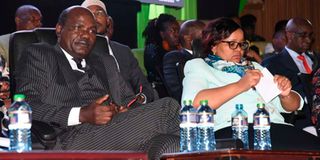Ruto, Raila pile more pressure on IEBC over results transmission

IEBC Chairman Wafula Chebukati (left) and vice chairperson Juliana Cherera at the Bomas of Kenya on June 9, 2022 during the first testing and simulation of results transmission. Azimio la Umoja and Kenya Kwanza have issued fresh demands to the electoral agency regarding transmission of results in areas with no network coverage.
Deputy President William Ruto and Azimio la Umoja One Kenya Coalition flagbearer Raila Odinga have issued fresh demands to the electoral agency regarding transmission of results in areas with no network coverage.
The two frontrunners Wednesday demanded answers from the Independent Electoral and Boundaries Commission (IEBC) on how results from 1,111 polling stations will be transmitted to the national tallying centre.
Through Gladys Shollei and Dr Caroline Karugu, who represented Dr Ruto and Mr Odinga, respectively, they wondered why some of the affected stations were not included in the Tuesday simulation exercise.
“We want to know how results from the 1,111 stations will be transmitted to the national tallying centre,” Ms Shollei said at the Bomas of Kenya.
Streaming still slow
Dr Karugu said although Tuesday’s simulation registered a 94 per cent success rate, much more than 58 per cent registered in the first dry run, she expressed fears that the streaming was still slow.
“If only 50 stations have transmitted their results in one hour, simple mathematics means that Kenyans will have to wait for about four days to get the final presidential results,” said Dr Karugu, who is Azimio’s deputy chief agent.
Commissioner Abdi Guliye said a simulation exercise for the affected stations will be conducted for presidential technical teams.
“We’ll host the technical teams of the presidential agents at our warehouse, where we are preparing the Kiems kits. There’ll be an in-house demonstration on the role of the satellite modems,” he said.
Stations with no 3G network
IEBC’s ICT Director Michael Ouma said they will meet with the technical teams today (Thursday). The commission is yet to gazette stations with no 3G network, one of the factors that led to the nullification of the 2017 presidential poll.
Commissioner Justus Nyang’aya, who is in charge of ICT, said the stations will be gazetted next week.
“We are still confirming the strength of the 3G networks in those places. This was a problem in 2017. We were asked where some of the results we declared came from since they were not from gazetted areas,” he said.
Mr Nyang’aya said the commission has started deploying Kiems kits to far-flung areas in North Eastern.
“Commissioners were at the warehouse on Tuesday to confirm the deployment of the kits. While some are still being sorted, others have already been dispatched. We want to ensure they are sent to all areas five days before elections,” he offered.
Security system
The commission also faced questions from political parties on the security system as it failed to demonstrate how the kits will reject transmission of any result emanating from other documents.
The commission on Tuesday told political party agents and election observers that it has enhanced security features on the kits and forms 34A that contain presidential results from polling stations. The forms will contain quick response (QR) codes.
The kits will have in-built validation checks and will only contain IEBC SIM cards with specific codes. This means they cannot be used in any other device other than the one it has been configured to work on.
IEBC chairman Wafula Chebukati said they will continue cooperating with political parties and urged stakeholders to raise any issues that will help them to deliver credible elections on August 9.





